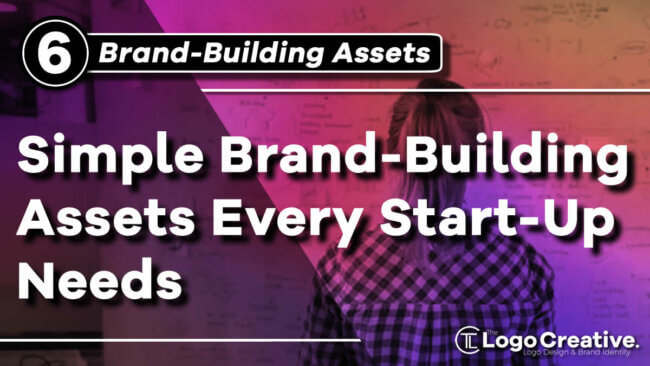When you’re about to launch your new company, there is one crucial step to follow, which can make or break the way the business will be seen in the public eye. And that crucial step is BRANDING. In this article we share 6 Simple Brand-Building Assets Every Start-Up Needs.
Branding may mean various things, though one key element is its visual identity, which is what YOU create. This would communicate what your company is all about and is usually the first interaction any potential customer would have with the company.
Because of this, designing the company’s brand identity is a vital part of establishing your business.
But what is a brand and where can you start building it? Read on to find out!
Table of Contents
What is a Brand?
The brand is defined by your customers’ perception of your company or business. According to Jeff Bezos, founder of Amazon, “your brand is what other people say about you when you’re not in the room.”
It is your reputation and what people think of what your business is, which makes or breaks your company.
Today, successful brands need to be consistent in both communication and experience and in various applications, including:
- Your environment like the office and storefront
- Print collateral, packaging, signages
- Websites and online ads
- Publishing content
- Customer and sales services
- With your employees
What is a Brand Building?
Now that you are familiar with what a brand is for business, what is brand building?
Brand building refers to generating and spreading awareness about your business.
How do you do that? With various campaigns and strategies that have a goal of creating a unique and lasting image in your industry.
We break down branding into three stages:
- Strategy
- Identity
- Marketing
Brand strategy maps out how your start-up is different and trustworthy, as well as memorable to your ideal customers. This conveys purpose and promises, as well as how your business will solve problems.
Brand identity is how you’ll convey your strategy to the public, utilizing messaging, experiences, visuals, etc. Your brand’s strategy influences the way you present the identity, aligning it with the start-up’s purpose. This will create the most impact.
Brand marketing is how your start-up will highlight and bring awareness to the products and/or services you offer through connecting your values and voice to target audiences.
This is done through strategic forms of communication and digital marketing activities, including:
- Improved user experience on your website
- Content and SEO marketing
- Email and social media marketing
- Paid advertising
Simple Brand-Building Assets for Your Start-Up
Next up is learning how to build your start-up’s brand using assets. Here are the following assets you need and how to bring out the best of these assets to build your brand successfully:
1. Create a Brand Guide
When you have the assets, you need to meet the bare minimum for solid brand building, it’s crucial you take time to present what you’re working in. This is known as a style guide, brand guidelines, or even a brand book.
Whatever you call this brand guide, it’s a necessary part of building your brand.
This is your bible, putting everything you need to do starting now and the future. This is where you can get advice on where to go as you continue building your brand’s voice and mission. This doesn’t just go for your brand’s design and assets, but the internal culture, too.
If the brand voice and mission statement has the word “peaceful”, then prioritize making the work environment peaceful, making all clients feel at peace as they transact with you, and have the voice that exudes softness and relaxation.
This will help with your brand’s consistency for the years to come. As you create your brand guide, place all the brand elements in it, clearly communicated, so when you go back for it (maybe when creating new advertisements and content), you know what to add and how to design the next campaigns so your brand is clearly there.
You can make your brand guide using a Google Slide deck or PowerPoint presentations, both of which are free!
2. Build a Good Logo and/or Mascot
When building a brand, the first thing that comes into mind are the visuals. Your logo is probably the most exciting and crucial piece of your brand building process since this will appear on anything and everything related to the business.
The logo will be your identity, your calling card, the visual recognition of what you promise to people. Because of this, you need to invest time and money to create an exceptional logo that speaks out to people and reinforces your visual identity.
It’s best that you hire a professional designer with experience who can help with your logo creation and brand identity, so your brand and business stand out. With someone’s expertise, they can get you the unique and timeless mark your business needs, as well as help you develop brand guidelines for the future.
You can also consider getting a mascot, which is another critical and helpful asset for your branding. You don’t need to go all out here, even just a simple and minimal mascot that exudes the mood you’d like to convey will help.
For instance, a puppy holding a leaf for a pet brand. The cuteness of the puppy mascot attracts attention while matching it with a warm and natural color palette that can help tell your brand’s story, which is filled with loyalty and warmth.
3. Write an Excellent Brand Mission Statement
Your entire business, including your branding, requires a brand mission statement! You have to craft out what your company is about and what its passions are. This statement is your why, the reason your business exists, and what you work for.
Before even beginning to build your brand, you have to know what your business value is and what you can provide. This will then help inform the other elements of your next brand-building strategies.
Remember- everything in your brand-building efforts, from logo down to personality, needs to reflect your brand mission statement.
If you’ve noticed the infamous brand’s mission statements, they are reduced to the bare minimum, describing their business impact in just a few words.
Follow the simplicity and minimalist approach other brands do and tie this statement to what you create for your start-up, communicating the voice of your brand.
4. Research Your Competitor Brands
If there’s one thing you should follow, it’s to never copy exactly what bigger brands are doing within the industry. Don’t be just another copycat of your competitor, because if you offer the exact same things, people would be more inclined to choose the bigger and well-known brand!
With that in mind, you should know more about what they excel and fail in.
The goal here isn’t to copy what the competition does, but to differentiate yourself from them for people to choose you. That’s why competitor research is important, starting off with seeing how well they’ve done when building their brand name.
You can create a brand competitor research spreadsheet, utilizing competitor research tools. Once you have your research, you can build strategies around how to differentiate yourself from the competition and convince people to purchase you over big brands!
5. Determine Your Brand’s Target Audience
The foundation when a brand building is to identify your target audience. You won’t be able to be everything to everyone, which is why you should be mindful of who you want to reach.
This will help you tailor both your message and mission, meeting your target audience’s needs.
In here, you should be specific, identifying detailed behaviors and the lifestyle of target consumers. For instance, rather than saying your target audience is just “college students”, become more specific, like “college students studying in Asia during their summer break”.
Target a niche and commit to something to focus on, so narrow down the target audience focus so you’re sure that the brand message will come across clearly.
6. Put Out Key Qualities and Benefits Your Brand Provides
You’ll always face brands that have bigger budgets and/or more resources when commanding their industry. BUT, the products and services, along with its benefits, belong to only you.
When you start a memorable brand name, you have to dig deep and find out what you can offer that no one else does.
As you build your brand, focus on both the key qualities and benefits which help make your brand unique. Basically, give your target audience the reasons why they should choose you over anyone else.
Don’t just list down product and service features, but the value your offerings provide that will improve the life of your target audience.
That way, people who come across your brand and business will remember you better and will be more inclined to choose to transact with you because they believe your offerings have what it takes to solve any problems they have.
Bottom Line
As a start-up, building your branding is one of the first steps. But it isn’t just about slapping in any logo and assuming people will recognize you immediately.
Building your brand goes farther than that, which tells you more about not just your company, but your story.
This can help reach potential customers, even more, touching their hearts as they learn about your mission and values, relaying your message clearly.
However, this only works effectively when you know how to build your brand properly.
Thanks to these tips and knowledge on branding, you now have a foundation to build on, beginning your journey to creating and sharing your brand with your target audience.
Use these tips and reap the benefits of effective brand-building offers now.
Good luck!
Join The Logo Community
We hope you have enjoyed these 6 Simple Brand-Building Assets Every Start-Up Needs.
If you would like more personal tips, advice, insights, and access to our community threads and other goodies join me in our community.
You can comment directly on posts, access our community threads, have a discussion and ask questions with our founder Andrew.
If you’re looking to learn more about brand strategy, we highly recommend eRESONAID with our friend and acclaimed brand strategist and author Fabian Geyrhalter, it’s packed full of knowledge and insights you will need to learn to become a brand strategist or apply what you learn within your own business.
 Author bio:
Author bio:
Joel House is an SEO Expert and the founder of Joel House SEO Sydney. He loves helping business owners and grow their business with higher success around the world. Joel House has the reputation and experience that you need to take your business to the next level


